

Critical Thinking Model 1. To Analyze Thinking We Must Identify and Question its Elemental Structures Standard: Clarityunderstandable, the meaning can be grasped Could you elaborate further?
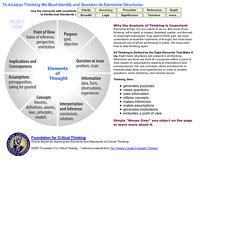
Why Do Teachers Ask the Questions They Ask? Although teacher questioning has received much attention in the past few years, studies on teacher questions in the ESL classroom have so far revolved around the ‘closed’/‘open’ or ‘display’/‘referential’ distinction.

Findings from classroom observations show excessive use of closed questions by teachers in the classroom. The argument that has been more or less accepted is that such questions seek to elicit short, restricted student responses and are therefore purposeless in the classroom setting. Thought Questions - Asking the right questions is the answer. Bloom's taxonomy. "Taxonomy” simply means “classification”, so the well-known taxonomy of learning objectives is an attempt (within the behavioural paradigm) to classify forms and levels of learning.
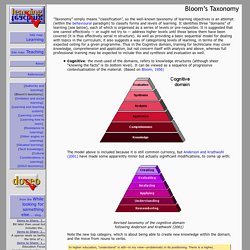
It identifies three “domains” of learning (see below), each of which is organised as a series of levels or pre-requisites. It is suggested that one cannot effectively — or ought not try to — address higher levels until those below them have been covered (it is thus effectively serial in structure). As well as providing a basic sequential model for dealing with topics in the curriculum, it also suggests a way of categorising levels of learning, in terms of the expected ceiling for a given programme. How to Encourage Higher Order Thinking. Why Use This Tip What To Do Why Use This Tip A main goal of educators today is to teach students the skills they need to be critical thinkers.

5 Powerful Questions Teachers Can Ask Students. My first year teaching a literacy coach came to observe my classroom.

After the students left, she commented on how I asked the whole class a question, would wait just a few seconds, and then answer it myself. "It's cute," she added. Um, I don't think she thought it was so cute. I think she was treading lightly on the ever-so shaky ego of a brand-new teacher while still giving me some very necessary feedback.
Culture of thinking. Blooms-verbs.jpg (JPEG Image, 756 × 567 pixels) Scientific Observation - Collecting Empirical Evidence. Scientific observation is the central element of scientific method or process.
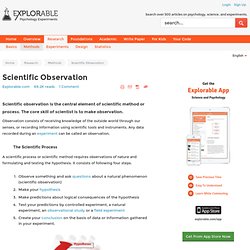
The core skill of scientist is to make observation. Observation consists of receiving knowledge of the outside world through our senses, or recording information using scientific tools and instruments. Any data recorded during an experiment can be called an observation. The Scientific Process. UIS Active Learning. DESCRIPTIONActive learning is a term referring to the engagement of students in some way with the topic to be learned.
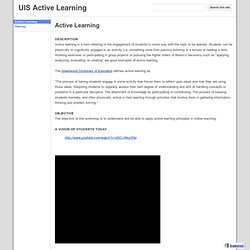
Students can be physically or cognitively engaged in an activity (i.e. something more than passive listening to a lecture or reading a text). Working exercises or participating in group projects or pursuing the higher orders of Bloom's taxonomy such as "applying, analyzing, evaluating, or creating" are good examples of active learning. Masters Degree (Evaluation) – Module 5 – “A Brief Look Back”. Introduction.

Writing a evaluation before the true end of any project, and so without the true distance of hindsight, will have its problems. So this text will tend to focus more on the overarching themes that instigated the study as well as a the influences upon those primary changes in attitude and practice that have come about through my studies. P-41-english1386.pdf. A Study on Senir High SchoolStudents' Cognitive Skill by Analyzing Th… Interaction analysis. Full_64.pdf. When #SOLO Met Bloom Taxonomy. If you are interested in the thinking (thinking might be too strong a term for what I was actually doing) that brought me to explore this relationship you might want to look at a previous post, “Posts Move, Goals Don’t.”

Bloom’s Taxonomy Many of us are familiar with Bloom’s Taxonomy (1956) – or at least we think we are! The standard list that I was given during teacher training consisted of: KnowledgeComprehensionApplicationAnalysisSynthesisEvaluation Did you know it was revised in 2000 or that it consisted of a set of four knowledge dimensions? Colombian Applied Linguistics Journal - Instructional Materials: A platform to enhance cognitive skills and writing development.
Colombian Applied Linguistics Journal - Working by projects: A way to enrich critical thinking and the writing process in a third grade EFL classroom. Working by projects: A way to enrich critical thinking and the writing process in a third grade EFL classroom Trabajo por proyectos: pensamiento crítico y proceso escritural en inglés en un salón de tercero de primaria Sandra Dolores Ruiz Niño* Colegio José María Carbonell carirasa@yahoo.com *Sandra Dolores Ruiz Niño is an elementary school teacher.
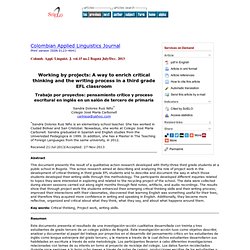
She has worked in Ciudad Bolivar and San Cristobal.